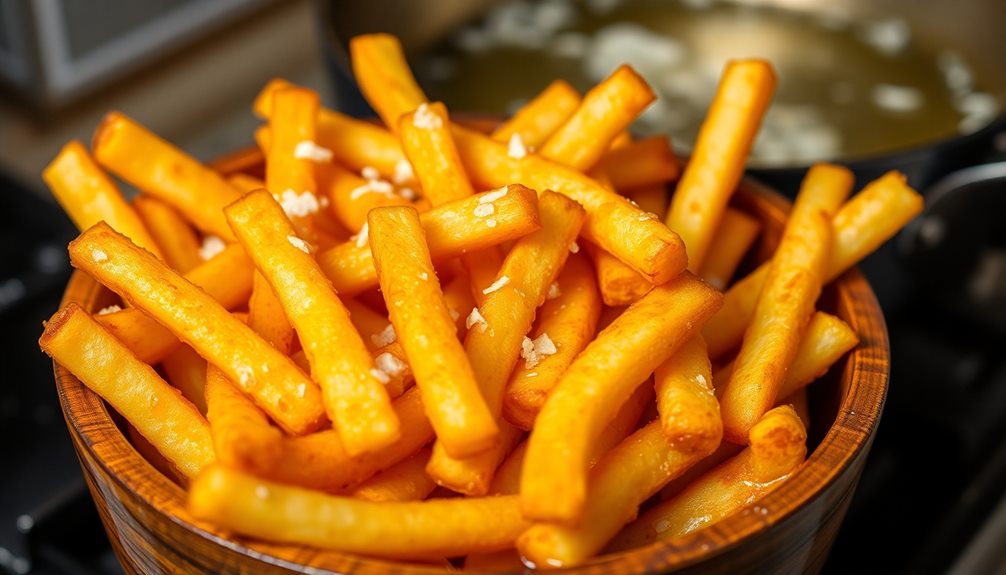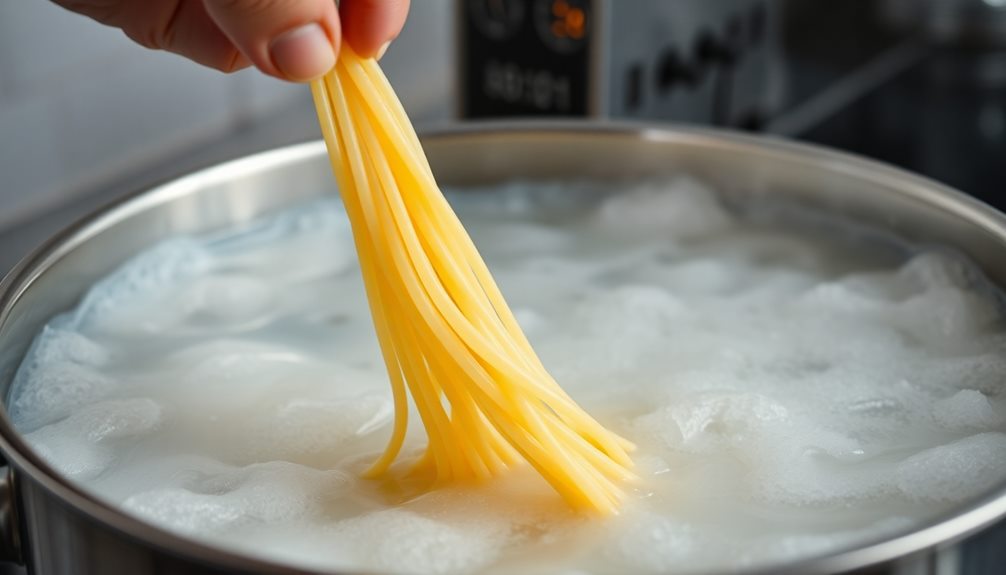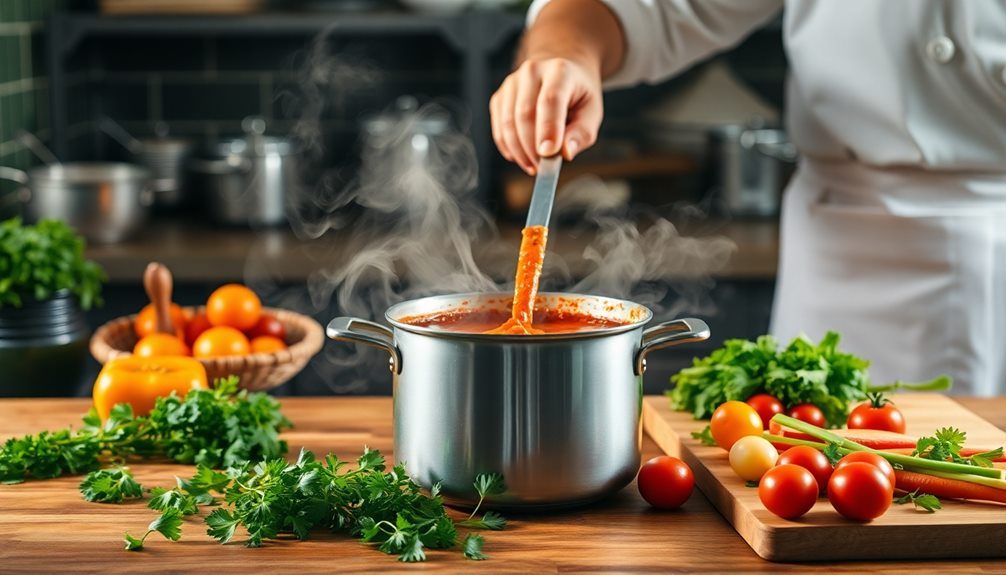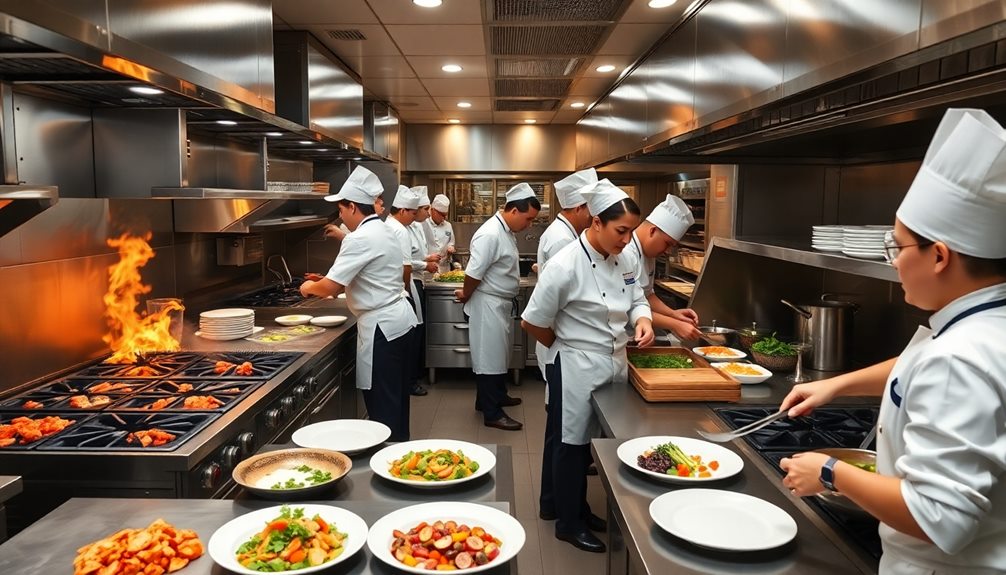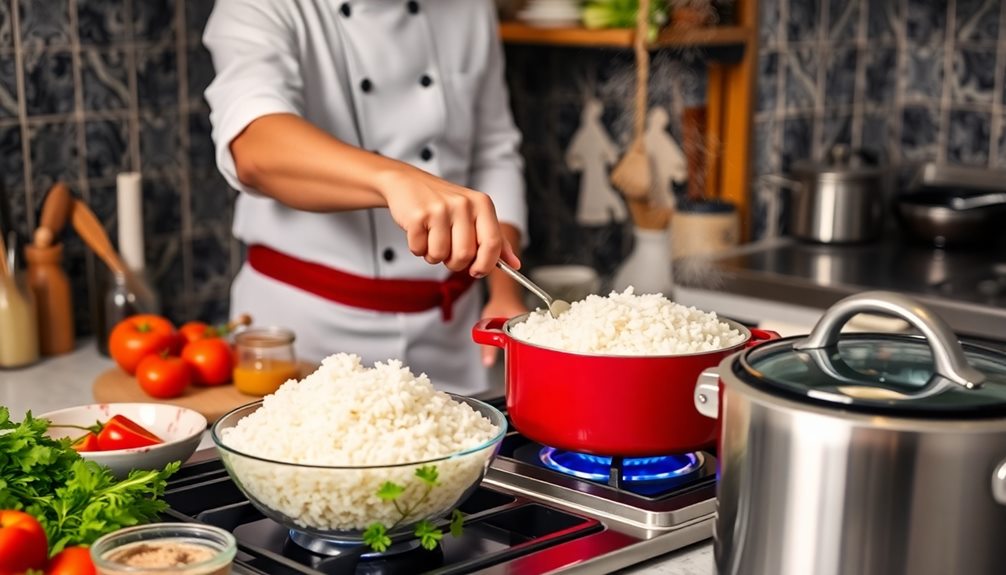Restaurants make crispy French fries by using the right techniques and exceptional ingredients. First, they choose starchy potatoes like Russets and soak them to remove excess starch. They blanched the fries in oil at a lower temperature before frying them again at a higher temperature. Using fresh, high-quality oil is key; oils like avocado or duck fat work best. They avoid overcrowding during frying so the fries cook evenly. Finally, seasoned immediately after frying, they serve them warm. There's a lot more that goes into perfecting fries, so stick around to discover additional tips and tricks!
Key Takeaways
- Restaurants use starchy potatoes like Russet for optimal crispiness, avoiding waxy varieties that retain moisture.
- Potatoes are soaked in cold water to remove excess starch before being cut into uniform batons.
- A double-fry method is employed, first frying at a lower temperature, then at a higher temperature for crispiness.
- Fresh, high-quality oils with appropriate smoke points are used, ensuring the fries achieve a desirable texture and flavor.
- Fries are seasoned immediately after frying and served in warm containers to maintain crispiness.
Essential Equipment for Frying
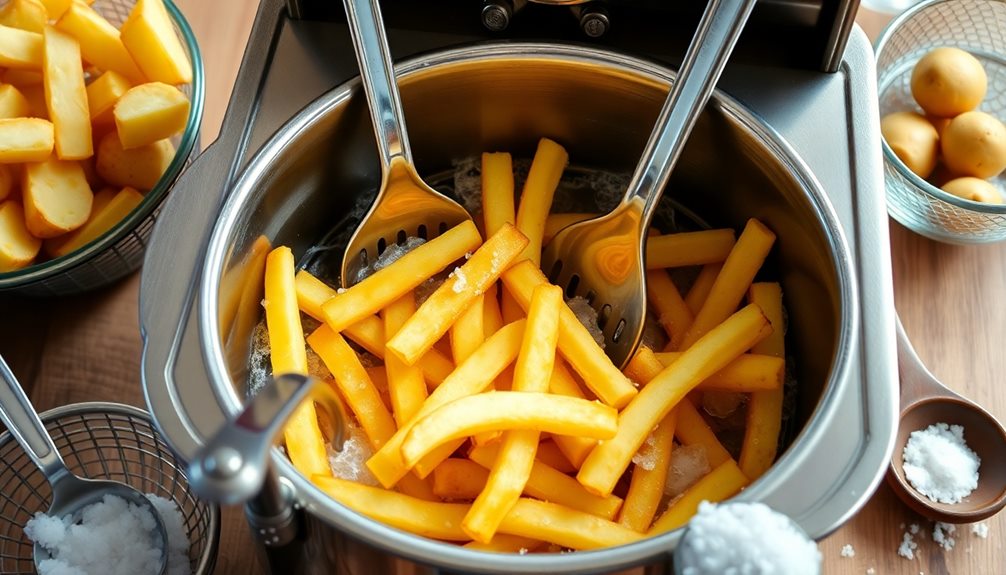
When it comes to frying the perfect French fries, having the right equipment is essential. If you want to achieve that crispy texture, investing in high-quality equipment is key. Restaurants often rely on commercial-grade deep fryers that provide precise temperature accuracy, ensuring that each fry cooks evenly and comes out perfectly golden.
These fryers are designed for superior performance, much like the best vacuums for hardwood floors that offer specialized features for effective cleaning.
Using specialized fryers allows for larger oil volumes, which means you can deep fry multiple batches without compromising quality. This larger capacity contributes to consistent fry quality, something that's hard to replicate with smaller home setups.
Plus, heavy-duty frying pots or commercial fryers help maintain oil temperature during cooking, preventing your fries from becoming greasy or soggy.
With better oil management, restaurants can utilize oil more efficiently, leading to a crispier bite that you'll crave. The right equipment isn't just about frying; it's about creating a reliable process that guarantees delicious results every time.
The Role of Oil Quality
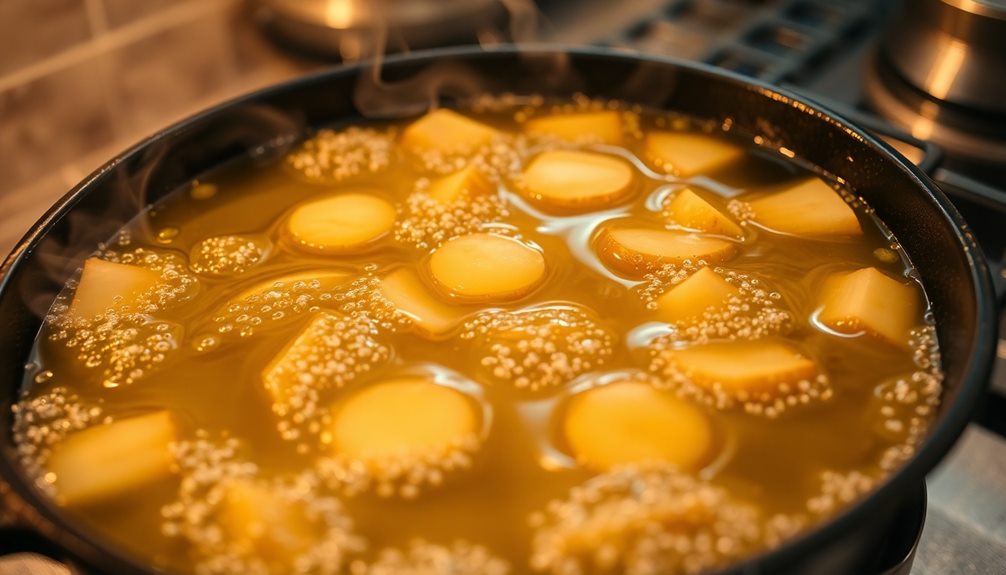
When it comes to frying crispy French fries, the quality of your oil plays an essential role.
Fresh oil mightn't give you the same texture as slightly used oil, which develops better molecular bonds over time.
Plus, you need to watch for any signs of degradation, like smoking, to guarantee you're frying with the best possible oil.
Freshness and Smoke Point
To achieve perfectly crispy French fries, restaurants turn to high-quality oils with ideal smoke points that prevent burning during frying. Fresh oil is essential in this process, as it maintains temperature stability and avoids off-flavors that can ruin your fries.
Oils like avocado oil, duck fat, and tallow are popular choices thanks to their high smoke points, typically around 375°F. This temperature allows for effective frying without the oil degrading or smoking, ensuring that each fry comes out golden and crispy.
Using fresh oil not only helps in achieving that desired texture, but it also contributes to the overall flavor of the fries. Over time, oil quality deteriorates, leading to less satisfying results. That's why restaurants regularly replace their oil to maintain consistent frying performance.
Interestingly, slightly used oil can actually yield crispier fries due to molecular bonding that occurs, making it more effective in delivering the perfect fry texture. However, the balance is key, as overly used or rancid oil can negatively affect your fries.
Oil Degradation Effects
Oil quality plays an important role in the texture and flavor of your French fries. Understanding oil degradation is key to achieving that perfect crispy fry. Here are some factors to take into account:
- Fresh oil yields soggy fries.
- Slightly used oil enhances crispiness.
- Ideal frying oil lasts about a week.
- High smoke point oils perform better.
- Proper storage is vital for quality.
When you fry in fresh oil, it mightn't bond well with the fries, leading to a soggy texture.
However, slightly used frying oil can improve the molecular bonding, giving you that desired crunch. Over time, oil quality diminishes, usually within a week, as it begins to smoke and degrade, affecting your fry texture negatively.
Restaurants thrive on continuous frying, allowing the oil to develop better qualities, resulting in consistently crispy fries.
If you're cooking at home, think about using oils with high smoke points like avocado or beef tallow, which maintain their frying quality longer.
Remember, even refrigerated oil can degrade, so proper management is essential to keep your fries crispy.
Prioritize oil quality, and you'll elevate your French fry game!
Understanding Oil Lifespan
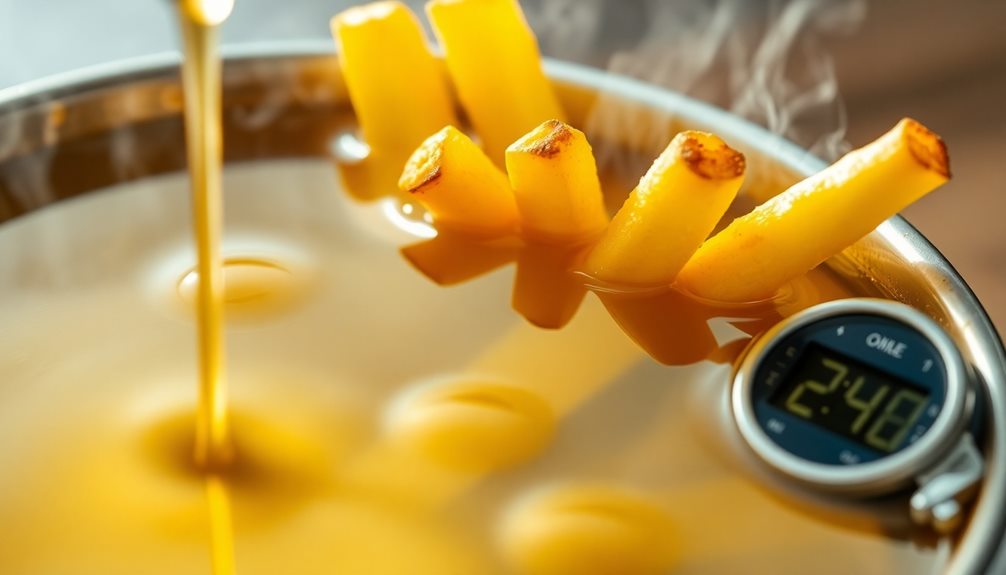
Understanding the lifespan of cooking oil is essential for achieving perfectly crispy French fries. Oil has a limited lifespan, and its quality starts to diminish after about a week in storage. This decline impacts the texture and crispiness of your fries.
Even when you store oil in the fridge, degradation continues, which means that previously used oil often performs better for frying than fresh oil.
You might be surprised, but slightly used oil can actually produce crispier fries. This happens because of the molecular bonding that occurs with continuous use, enhancing the frying capabilities over time.
In restaurant kitchens, chefs maximize oil performance by frequently frying with the same oil, allowing it to reach its peak crispiness potential.
However, keep an eye on the oil's condition. Overly degraded oil begins to smoke, signaling that it's time to stop using it for frying.
Using fresh oil may seem appealing, but remember that well-used oil can be key to achieving those perfectly crispy French fries you crave.
Importance of Blanching
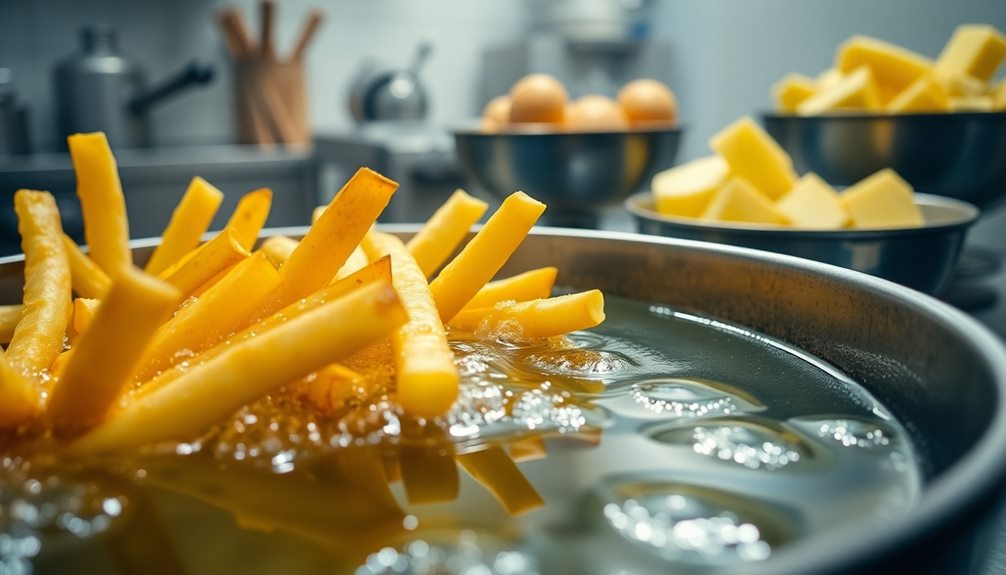
Blanching is an essential step in achieving those perfectly crispy French fries you love.
By soaking the potatoes in hot water, you reduce moisture and activate the starches, which enhances their crispiness.
This initial technique sets the stage for that fluffy interior while preventing any gummy texture during frying.
Blanching Enhances Crispiness
Achieving perfectly crispy French fries hinges on an essential pre-frying step: blanching. This technique involves briefly cooking your potatoes in water at 300°F for about 3-5 minutes. By doing so, you remove excess moisture, which is important for achieving that desired crispy texture when frying.
Here are some key benefits of blanching your fries:
- Removes moisture to prevent gummy fries
- Partially cooks the potatoes for a fluffy interior
- Enhances color to a golden brown during frying
- Maximizes crispiness through the double frying technique
- Ensures even cooking for consistently crispy results
Blanching not only prepares the fries for their final fry but also improves the overall quality.
It's a significant step in the double frying process, allowing restaurants to serve fries that stay crispy longer after cooking. By avoiding moisture buildup, you can guarantee that your fries maintain that irresistible crunch.
Moisture Reduction Techniques
To get those perfectly crispy French fries, managing moisture is fundamental, especially before the frying process begins. One of the most effective moisture reduction techniques is blanching. By blanching your potato sticks in water at around 300°F for 3-5 minutes, you partially cook them while allowing surface moisture to escape. This step is critical for achieving that desirable crispy texture.
Before you start blanching, remember to soak and rinse the potatoes. This helps to remove excess starch, which can lead to gumminess, guaranteeing a better fry texture.
After blanching, you can utilize a two-step frying technique: the first fry at a lower temperature cooks the interior, while the second fry at a higher temperature crisps up the exterior.
Don't forget that managing your blanching and frying times is essential, as is avoiding overcrowding in the frying pot. By following these tips, you'll assure even cooking throughout and enhance the overall crispiness of your fries.
Embrace these moisture reduction techniques, and you'll be well on your way to serving up perfectly crispy French fries that everyone will love.
Step-by-Step Frying Process
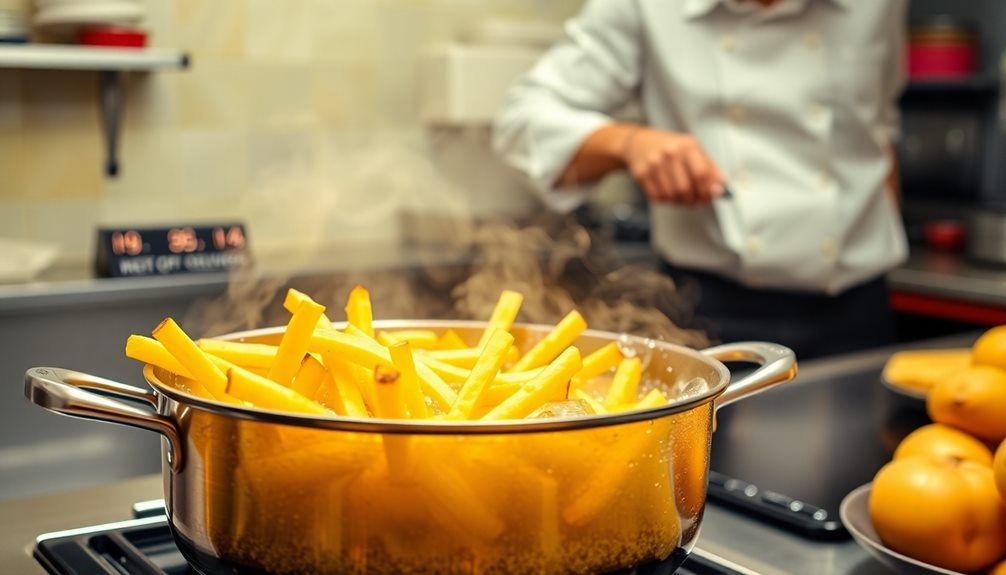
Creating crispy French fries involves a meticulous step-by-step frying process that guarantees perfect texture and flavor. To start, you'll need to prepare your starchy potatoes, preferably Russets. Cut them into 6 mm (1/4 inch) batons and soak these in cold water for at least 25 minutes. This helps remove excess starch that can lead to gummy fries.
- Rinse the potato sticks until the water runs clear.
- Dry them thoroughly on paper towels to prevent oil splattering.
- Blanch the fries in oil heated to 300°F for 3-5 minutes until partially cooked and not browned.
- Let them rest for about 5 minutes before the final fry.
- Increase the oil temperature to 375°F and fry the blanched fries in batches for another 3-5 minutes until they're golden brown and crispier.
Choosing the Right Oil
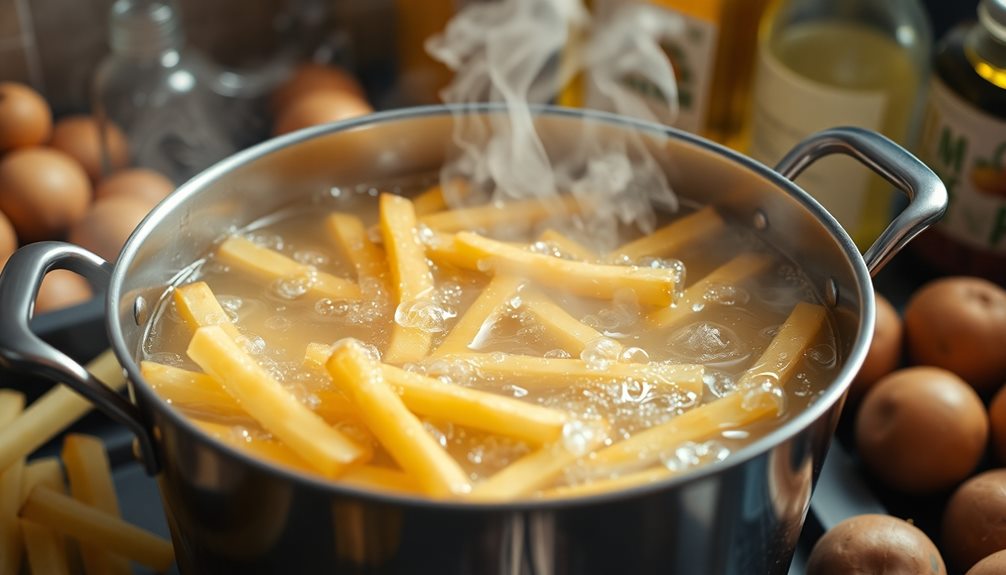
When you're selecting the right oil for frying French fries, it's important to take into account both flavor and frying performance.
You'll want to choose oils with high smoke points, like avocado oil, duck fat, or lard. These oils can withstand high heat without burning, ensuring your fries come out perfectly crispy.
The type of oil you use not only impacts the taste but also the healthiness of your fried French fries.
Opt for stable fats, such as beef tallow, which contribute both flavor and health benefits, unlike rancid oils often found in home kitchens.
Fresh oil is key to achieving that desirable crispiness; slightly used oil can enhance crispiness due to molecular bonding formed during continuous use.
Perfecting Potato Selection
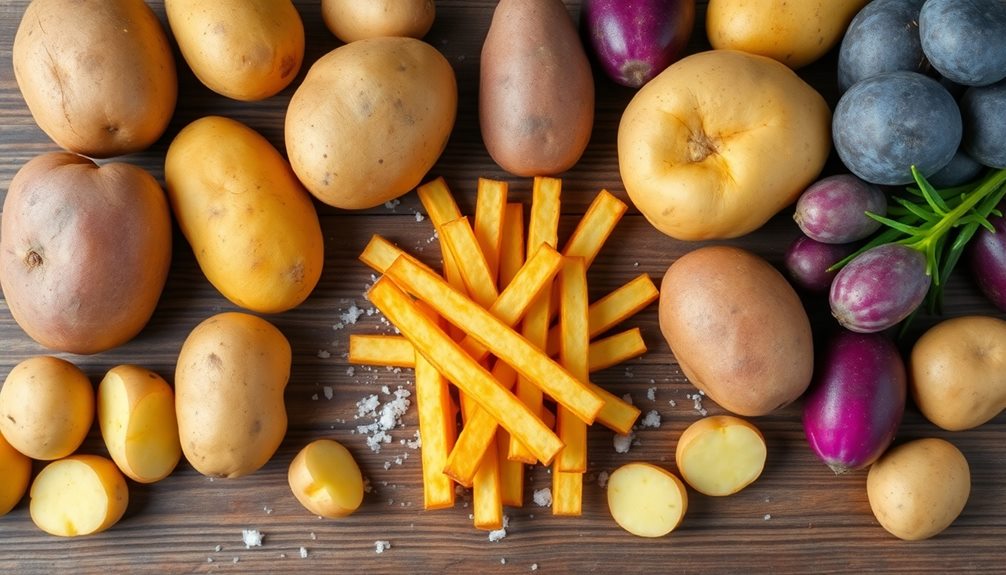
Selecting the right type of potato plays a significant role in achieving that perfect French fry. For the crispiest fries, you should focus on starchy, floury potatoes like Russet potatoes. These varieties have a high starch content that helps create a fluffy interior and a crispy exterior.
Avoid waxy potatoes, such as red or new potatoes, since their higher moisture content and lower starch levels lead to less crispy fries.
Here are some key tips to contemplate when selecting your potatoes:
- Choose starchy potatoes like Russet or Maris Piper.
- Opt for fresh potatoes, free of blemishes or green spots.
- Cut your potatoes into sticks about 6 mm (1/4 inch) thick for even cooking.
- Soak the potato sticks in cold water for at least 25 minutes to remove excess starch.
- Double-fry for that extra crunch!
Serving and Seasoning Tips
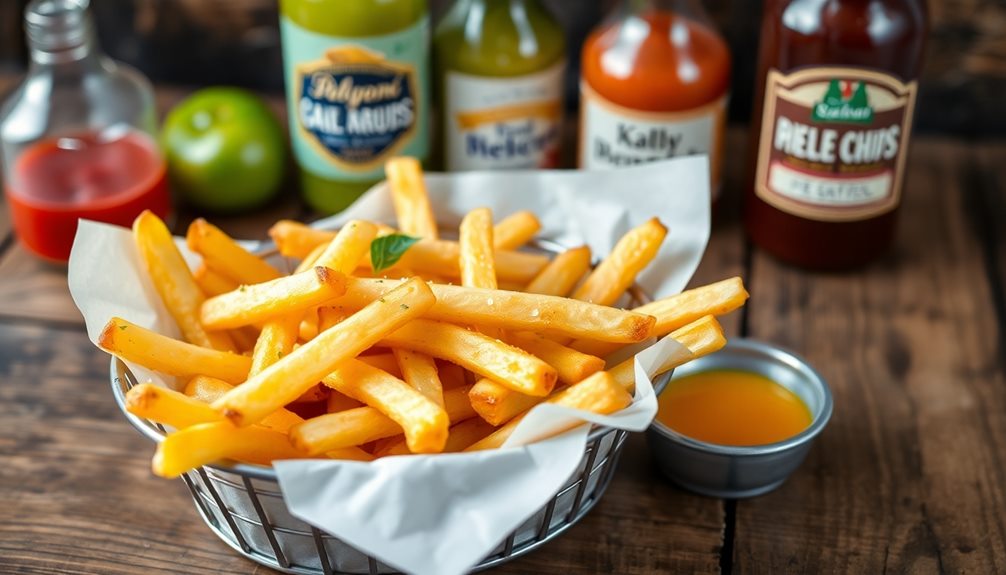
To truly elevate your French fries, it's essential to focus on serving and seasoning them just right. First, season your fries immediately after frying while they're still hot. This guarantees the salt adheres well and enhances flavor absorption.
Don't overlook the importance of serving fries in warm containers. Keeping them warm prevents sogginess and maintains that desirable crispiness you're aiming for.
To take your serving game up a notch, consider pairing your crispy French fries with a variety of dipping sauces. Classic options like ketchup are great, but don't shy away from gourmet choices like aioli or spicy mayo to elevate the dining experience.
For a unique flavor twist, experiment with gourmet seasonings, such as rosemary salt or truffle oil. These can add an unexpected depth to your fries.
Cooking Efficiency Techniques
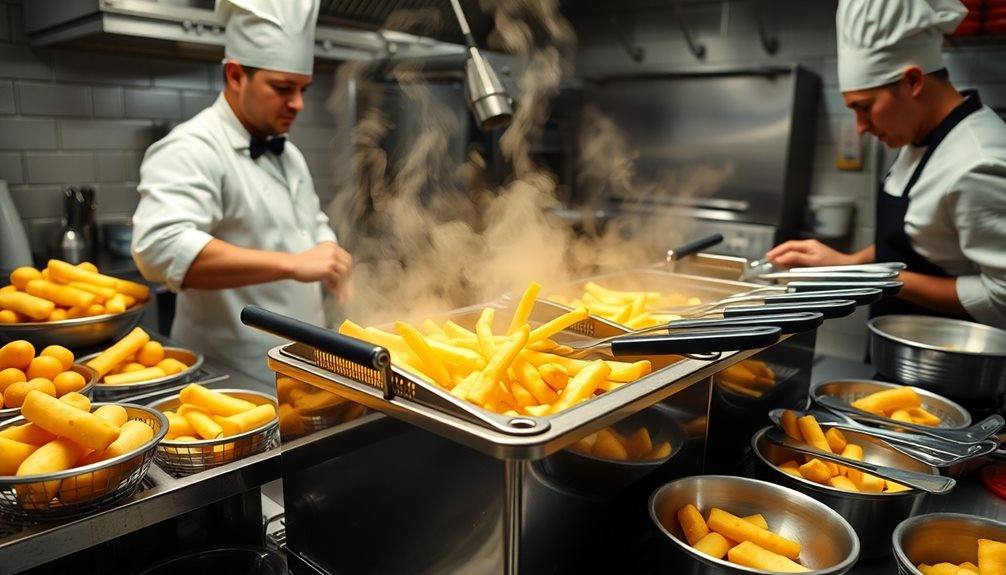
Achieving cooking efficiency is vital for restaurants aiming to serve perfectly crispy French fries. To master this, they utilize several key techniques that enhance both texture and flavor.
- Use commercial-grade fryers for precise temperature control
- Employ the double fry method for ideal crispiness
- Fry in batches to maintain oil temperature
- Choose high smoke point cooking oil
- Avoid overcrowding in the frying pot
The double fry method is particularly effective. First, fries are blanched at a lower temperature (around 300°F) to cook the interior. Then, they're fried again at a higher temperature (375°F) to achieve that coveted crispy exterior. This two-step process guarantees that you get the best of both worlds: a soft interior and a crunchy outside.
Frying in batches helps maintain the oil temperature, which is essential for even cooking and preventing sogginess. Additionally, regularly used cooking oil develops better frying capabilities over time, enhancing the fries' overall texture.
Frequently Asked Questions
How Do Restaurants Make French Fries so Crispy?
You'll notice that restaurants achieve crispy fries by using starchy potatoes, double frying them at different temperatures, and maintaining oil quality. Techniques like soaking and rinsing help prevent gumminess, ensuring that perfect crunch you love.
What Is the Coating on Crispy Fries?
You've got that golden, crunchy coating contrasting with the soft, fluffy interior. That's the magic of starchy potatoes and double frying, creating a deliciously crispy texture that's simply irresistible. Enjoy every bite!
What Do Most Restaurants Fry Their Fries In?
Most restaurants fry their fries in commercial-grade deep fryers, using oils like peanut or canola. These oils have high smoke points, ensuring your fries come out perfectly crispy and golden every time you order them.
Why Do French Fries Taste Better at Restaurants?
You know that feeling when you bite into a perfectly crispy fry? Restaurants achieve that magic through precise techniques, quality ingredients, and commercial fryers, making their fries simply irresistible compared to homemade versions.
Conclusion
To sum up, making crispy French fries is an art that combines the right equipment, quality oil, and proper techniques. Did you know that frying at a temperature of around 325°F can reduce oil absorption by up to 30%? By following the steps outlined, from blanching to seasoning, you can achieve that golden, crunchy perfection every time. So, gather your ingredients, heat up that oil, and enjoy the delicious results of your crispy fry adventure!
